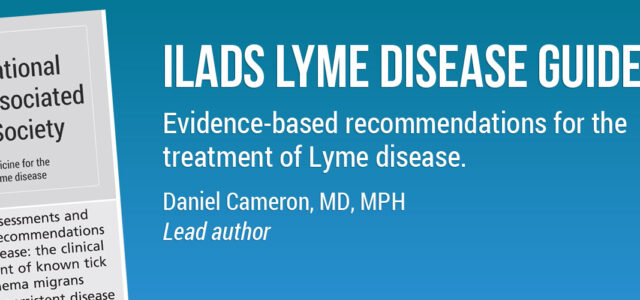Call for your appointment today 914-666-4665 | Mt. Kisco, New York

by Daniel J. Cameron, MD MPH
Altmetrics are metrics and qualitative data that are complementary to traditional, citation-based metrics that track and demonstrate the reach and influence of research publications to key stakeholders. [1]
The Altmetrics score “can signal that research is changing a field of study, the public’s health, or having any other number of tangible effects upon larger society,” according to the company’s website.
 ILADS published their guidelines in response to the growing number of chronic manifestations of Lyme disease, the high level of public concern, and the controversy over treatment approaches. [2] Previous guidelines by the Infectious Diseases Society of America (IDSA) had been criticized for not recognizing the existence and severity of chronic manifestations of Lyme disease. [3]
ILADS published their guidelines in response to the growing number of chronic manifestations of Lyme disease, the high level of public concern, and the controversy over treatment approaches. [2] Previous guidelines by the Infectious Diseases Society of America (IDSA) had been criticized for not recognizing the existence and severity of chronic manifestations of Lyme disease. [3]
The ILADS guidelines were developed using the Grading of Recommendations Assessment, Development and Evaluation (GRADE), which provides a transparent and systematic framework to assess and grade the available research to move from evidence to recommendations. GRADE considers the balance between the benefits and harm of various interventions, confidence in the estimates of effects, patient preferences and values, and resource use. [4]
The guidelines were peer reviewed and published in the open-accessed journal Expert Review of Anti-Infective Therapy [4] and accepted by the National Guideline Clearing House. [5] The guidelines were presented at professional conferences and incorporated into ILADS’ physician training program. [6]
There is evidence that the use of extended therapy, as recommended in the ILADS guidelines, is already being adopted by physicians. According to a 2011 survey, 50% of New England physicians believe “prolonged treatment [with antibiotics] was sometimes useful” and an estimated 25% thought it was “always useful.” [7]
A study, by Tseng which examined insurance claims data, found that 18% of Lyme disease patients were treated for more than 5 weeks (defined as extended therapy by the authors). [8] The actual length of time patients were prescribed antibiotics was much longer with an average of 86 days. Treatment duration ranged from 35 to 404 days.
Nearly half of Lyme disease patients (48.8%) were treated with more than 2 antibiotics. Doxycycline was prescribed in as many as 74.4% of Lyme disease patients. Azithromycin was prescribed in as many as 11.5% of Lyme disease patients. Amoxicillin and cefuroxime were also prescribed.
The use of extended therapy also involved switching from one antibiotic to another and/or combinations of antibiotics. The study found, 43% of patients were switched from one antibiotic to another, while 18% were prescribed combinations of antibiotics. The insurance claims data study was discussed in an All Things Lyme blog entitled “Hundreds of doctors treating Lyme disease with extended use and multiple antibiotics.”
There is no question the ILADS evidence-based guidelines are being disseminated. The real question is: Will implementation of their GRADE-based guideline reduce the frequency and severity of Lyme disease?
References:
- Altmetric Who’s talking about your research? at https://www.altmetric.com/. (Last accessed 5/8/16).
- Cameron DJ, Johnson LB, Maloney EL. Evidence assessments and guideline recommendations in Lyme disease: the clinical management of known tick bites, erythema migrans rashes and persistent disease. Expert Rev Anti Infect Ther, 1-33 (2014).
- Wormser GP, Dattwyler RJ, Shapiro ED et al. The clinical assessment, treatment, and prevention of lyme disease, human granulocytic anaplasmosis, and babesiosis: clinical practice guidelines by the Infectious Diseases Society of America. Clin Infect Dis, 43(9), 1089-1134 (2006).
- Cameron DJ, Johnson LB, Maloney EL. Evidence assessments and guideline recommendations in Lyme disease: the clinical management of known tick bites, erythema migrans rashes and persistent disease from Expert Review of Anti-infective Therapy 2014 at https://www.tandfonline.com/doi/full/10.1586/14787210.2014.940900. (Last accessed 1/3/16).
- Evidence assessments and guideline recommendations in Lyme disease: the clinical management of known tick bites, erythema migrans rashes and persistent disease. National Guideline Clearinghouse. Agency for Health Care Research and Quality. Available from: https://www.guideline.gov/content.aspx?id=49320. (Last accessed 10/11/15).
- https://www.ilads.org/. (last accessed 5/8/16.).
- Macauda MM, Erickson P, Miller J, Mann P, Closter L, Krause PJ. Long-Term Lyme Disease Antibiotic Therapy Beliefs Among New England Residents. Vector borne and zoonotic diseases, (2011).
- Tseng YJ, Cami A, Goldmann DA, DeMaria A, Jr., Mandl KD. Incidence and Patterns of Extended-Course Antibiotic Therapy in Patients Evaluated for Lyme Disease. Clin Infect Dis, (2015).



